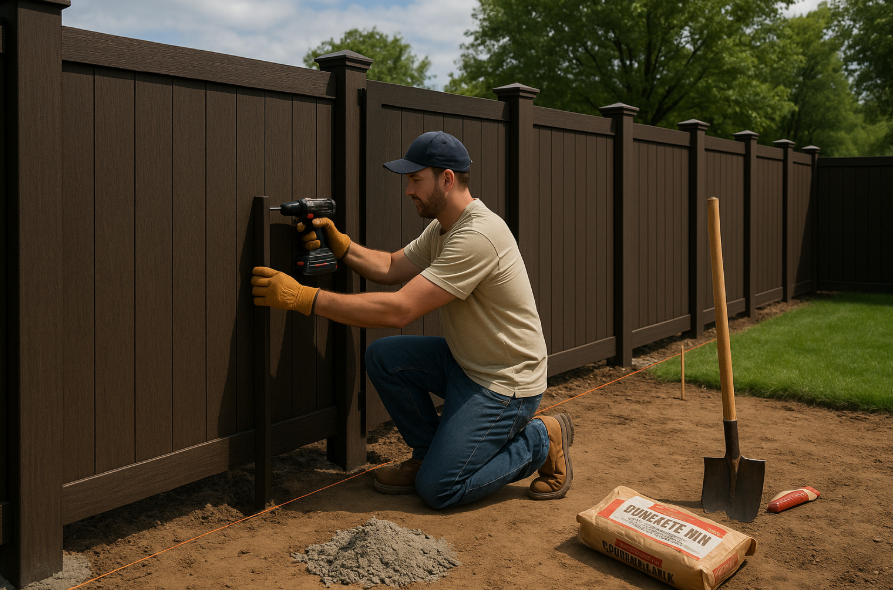Table of Contents
When it comes to modern fencing, composite fences have emerged as one of the most attractive, durable, and low-maintenance options for residential and commercial properties. While many homeowners love the aesthetics and benefits, the installation process is just as important to understand. Whether you’re planning a DIY project or hiring professionals, knowing what’s involved can help ensure a long-lasting, seamless result.
In this comprehensive guide, we’ll walk you through everything you need to know about composite fence installation from preparation to final panel fitting.
Why Choose Composite Fencing?
Before diving into the installation process, it’s worth highlighting why composite fencing is a top choice:
- Low Maintenance: No painting, sealing, or staining required.
- Long Lifespan: Typically lasts 25–30+ years.
- Weather Resistant: No warping, rotting, or rusting.
- Sustainable: Made from recycled wood and plastic.
- Aesthetically Versatile: Available in various colors and finishes.
Accel Inc offers high-quality composite fencing kits that make installation simpler and more efficient for both professionals and first-time DIYers.
Tools & Materials You’ll Need
To ensure a smooth installation, gather the following tools and materials beforehand:
Tools:
- Tape measure
- Post hole digger or auger
- Level
- Rubber mallet
- Power drill
- Concrete mix
- String line & stakes
- Saw (for trimming panels if necessary)
- Safety gloves and goggles
Materials:
- Composite fence panels
- Fence posts
- Post caps
- Screws or brackets (usually included with kits)
- Gravel (for post drainage)
- Concrete (for post setting)
Step-by-Step Composite Fence Installation Guide
Step 1: Planning and Layout
Start by measuring the full length of the area where the fence will be installed. Mark the location of each fence post using stakes and string lines to ensure straight alignment.
- Spacing: Check your fencing kit or local regulations for proper spacing. Typically, composite fence posts are set 6 to 8 feet apart.
- Permits: Be sure to check with your local municipality or HOA regarding zoning laws or height restrictions.
Step 2: Digging Post Holes
Use a post hole digger or auger to dig holes at each marked post location.
- Depth: Generally, dig at least 1/3 the post height deep, plus 6 inches for gravel. A typical depth is 24–36 inches.
- Width: Make the hole around 10–12 inches wide to accommodate concrete.
Step 3: Preparing the Post Base
- Pour 6 inches of gravel into each hole to improve drainage.
- Insert the post and use a level to ensure it is perfectly vertical.
- Mix and pour concrete into the hole around the post base. Slope the top of the concrete slightly to direct water away from the post.
- Allow the concrete to cure for at least 24 hours before proceeding to panel installation.
Pro Tip: Use temporary bracing to keep posts in place while the concrete sets.
Step 4: Attaching Fence Panels
Once your posts are secure and fully cured, you can begin attaching the composite panels.
- Depending on the system, panels may slide into grooves, or they may be screwed or bracketed into place.
- Start from one end and work your way down the fence line.
- Use a level to check that each panel is installed evenly.
- Trim panels as needed to fit shorter sections at the end of the run.
Reminder: Follow the manufacturer’s guide for spacing between the ground and bottom of the panel to avoid water pooling.
Step 5: Adding Post Caps
Finish the fence by securing post caps on top of each fence post.
- Post caps add a finished look and help prevent water from entering the post core.
- Most caps can be snapped on or secured using exterior adhesive or screws.
Tips for a Successful Composite Fence Installation
- Check the weather forecast: Avoid pouring concrete in rainy conditions.
- Always double-check measurements before digging or cutting panels.
- Install one section at a time to maintain alignment.
- Use non-corrosive fasteners (usually included) to avoid rust stains.
- Leave slight expansion gaps if the fence is being installed in extreme climates.
Common Mistakes to Avoid
Avoiding these common pitfalls can save time, money, and hassle down the line:
|
Mistake |
Why It Matters |
|
Skipping drainage gravel |
Causes water retention and post damage |
|
Uneven post alignment |
Results in crooked or unstable fencing |
|
Using untreated wood tools |
Can cause stains or splits in composite material |
|
Ignoring ground slope |
Leads to uneven panel height or gaps |
|
Rushing concrete curing time |
Weakens post stability |
Should You DIY or Hire a Pro?
Installing a composite fence is a manageable project for experienced DIYers, especially if you’re using pre-measured kits. However, for larger yards, sloped terrain, or precise layouts, it may be worth hiring a professional to guarantee top-notch results.
Accel Inc partners with experienced installers across the country to ensure customers can access expert support if needed.
Cost of Installing Composite Fencing
Composite fencing has a higher upfront cost than wood or vinyl, but it pays off with lower maintenance and a longer lifespan.
Average Installation Costs (Materials + Labor):
- DIY Installation: $15–$30 per linear foot
- Professional Installation: $35–$60 per linear foot
Factors that influence cost include:
- Fence height and length
- Style and finish
- Ground conditions (flat vs sloped)
- Local labor rates
Final Thoughts
Installing a composite fence is one of the best ways to add style, privacy, and long-term value to your property. With the right tools, preparation, and guidance, the process is straightforward and rewarding.
Unlike traditional wood fencing that requires constant upkeep, composite fencing offers decades of maintenance-free performance and with modern installation kits, it’s easier than ever to achieve a polished, professional finish.
Why Choose Accel Inc for Your Composite Fence?
At Accel Inc, we specialize in high-performance composite fencing systems designed for durability, simplicity, and style. Our fences come with:
- Easy-to-follow installation guides
- All-in-one kits with hardware included
- A variety of panel designs and finishes
- Long-term warranties and expert support
Whether you’re building a backyard oasis or securing a commercial perimeter, Accel Inc has the solution to fit your vision.
Ready to get started? Contact us today for product options, installation guidance, or a custom quote.







